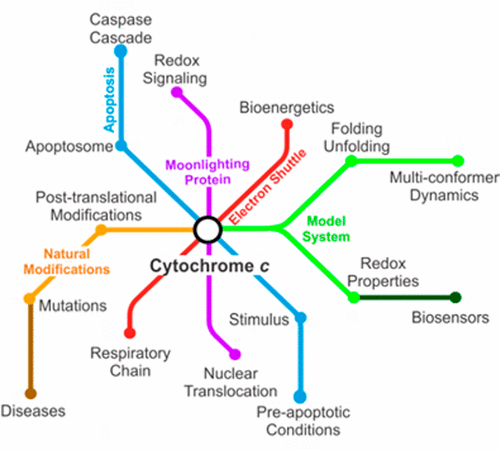当前位置:
X-MOL 学术
›
Chem. Rev.
›
论文详情
Our official English website, www.x-mol.net, welcomes your feedback! (Note: you will need to create a separate account there.)
Multifunctional Cytochrome c: Learning New Tricks from an Old Dog
Chemical Reviews ( IF 62.1 ) Pub Date : 2017-10-13 00:00:00 , DOI: 10.1021/acs.chemrev.7b00257 Damián Alvarez-Paggi 1 , Luciana Hannibal 2, 3 , María A. Castro 1 , Santiago Oviedo-Rouco 1 , Veronica Demicheli 3 , Veronica Tórtora 3 , Florencia Tomasina 3 , Rafael Radi 3 , Daniel H. Murgida 1
Chemical Reviews ( IF 62.1 ) Pub Date : 2017-10-13 00:00:00 , DOI: 10.1021/acs.chemrev.7b00257 Damián Alvarez-Paggi 1 , Luciana Hannibal 2, 3 , María A. Castro 1 , Santiago Oviedo-Rouco 1 , Veronica Demicheli 3 , Veronica Tórtora 3 , Florencia Tomasina 3 , Rafael Radi 3 , Daniel H. Murgida 1
Affiliation

|
Cytochrome c (cyt c) is a small soluble heme protein characterized by a relatively flexible structure, particularly in the ferric form, such that it is able to sample a broad conformational space. Depending on the specific conditions, interactions, and cellular localization, different conformations may be stabilized, which differ in structure, redox properties, binding affinities, and enzymatic activity. The primary function is electron shuttling in oxidative phosphorylation, and is exerted by the so-called native cyt c in the intermembrane mitochondrial space of healthy cells. Under pro-apoptotic conditions, however, cyt c gains cardiolipin peroxidase activity, translocates into the cytosol to engage in the intrinsic apoptotic pathway, and enters the nucleus where it impedes nucleosome assembly. Other reported functions include cytosolic redox sensing and involvement in the mitochondrial oxidative folding machinery. Moreover, post-translational modifications such as nitration, phosphorylation, and sulfoxidation of specific amino acids induce alternative conformations with differential properties, at least in vitro. Similar structural and functional alterations are elicited by biologically significant electric fields and by naturally occurring mutations of human cyt c that, along with mutations at the level of the maturation system, are associated with specific diseases. Here, we summarize current knowledge and recent advances in understanding the different structural, dynamic, and thermodynamic factors that regulate the primary electron transfer function, as well as alternative functions and conformations of cyt c. Finally, we present recent technological applications of this moonlighting protein.
中文翻译:

多功能细胞色素c:从老狗那里学习新技巧
细胞色素c(cyt c)是一种小的可溶性血红素蛋白,具有相对灵活的结构,尤其是三价铁形式,因此能够采样宽广的构象空间。取决于特定条件,相互作用和细胞定位,可以稳定不同的构象,这些构象在结构,氧化还原特性,结合亲和力和酶活性方面不同。主要功能是氧化磷酸化中的电子穿梭,并且由健康细胞的膜间线粒体空间中的所谓天然cyt c发挥作用。然而,在促凋亡条件下,cyt c获得心磷脂过氧化物酶活性,转运到细胞质中参与固有的凋亡途径,并进入细胞核,阻碍核小体的组装。其他报道的功能包括胞质氧化还原感应和参与线粒体氧化折叠机制。此外,至少在体外,翻译后修饰(例如特定氨基酸的硝化,磷酸化和硫氧化)可诱导具有不同特性的其他构象。类似的结构和功能改变是由生物学上重要的电场和人类细胞色素c的自然突变引起的与成熟系统水平的突变一起,与特定疾病相关。在这里,我们总结了目前的知识和最新进展,以了解调节主要电子传递功能以及cyt c的替代功能和构象的不同结构,动力学和热力学因素。最后,我们介绍了这种月光照蛋白的最新技术应用。
更新日期:2017-10-13
中文翻译:

多功能细胞色素c:从老狗那里学习新技巧
细胞色素c(cyt c)是一种小的可溶性血红素蛋白,具有相对灵活的结构,尤其是三价铁形式,因此能够采样宽广的构象空间。取决于特定条件,相互作用和细胞定位,可以稳定不同的构象,这些构象在结构,氧化还原特性,结合亲和力和酶活性方面不同。主要功能是氧化磷酸化中的电子穿梭,并且由健康细胞的膜间线粒体空间中的所谓天然cyt c发挥作用。然而,在促凋亡条件下,cyt c获得心磷脂过氧化物酶活性,转运到细胞质中参与固有的凋亡途径,并进入细胞核,阻碍核小体的组装。其他报道的功能包括胞质氧化还原感应和参与线粒体氧化折叠机制。此外,至少在体外,翻译后修饰(例如特定氨基酸的硝化,磷酸化和硫氧化)可诱导具有不同特性的其他构象。类似的结构和功能改变是由生物学上重要的电场和人类细胞色素c的自然突变引起的与成熟系统水平的突变一起,与特定疾病相关。在这里,我们总结了目前的知识和最新进展,以了解调节主要电子传递功能以及cyt c的替代功能和构象的不同结构,动力学和热力学因素。最后,我们介绍了这种月光照蛋白的最新技术应用。



























 京公网安备 11010802027423号
京公网安备 11010802027423号